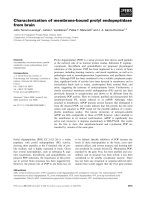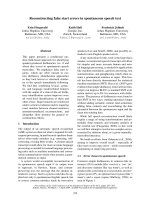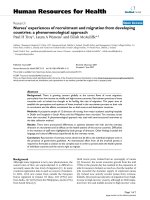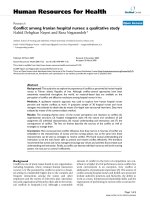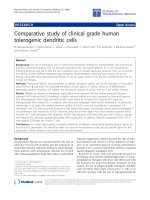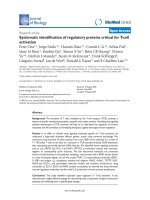Báo cáo sinh học : "Reconstructing prokaryotic transcriptional regulatory networks: lessons from actinobacteria" ppt
Bạn đang xem bản rút gọn của tài liệu. Xem và tải ngay bản đầy đủ của tài liệu tại đây (222.23 KB, 5 trang )
Minireview
RReeccoonnssttrruuccttiinngg pprrookkaarryyoottiicc ttrraannssccrriippttiioonnaall rreegguullaattoorryy nneettwwoorrkkss:: lleessssoonnss
ffrroomm aaccttiinnoobbaacctteerriiaa
Thiago M Venancio and L Aravind
Address: National Center for Biotechnology Information, National Library of Medicine, National Institutes of Health, Bethesda, Maryland
20894, USA.
Correspondence: L Aravind. Email:
TTrraannssccrriippttiioonn rreegguullaattoorryy nneettwwoorrkkss
Since the pioneering work of Jacob and Monod [1] nearly
half a century ago, which led to the operon model of
prokaryotic gene regulation, genetic and molecular studies
have deciphered the regulatory processes for a significant
fraction of the genome of Escherichia coli. In the same period
Bacillus subtilis too has risen to the status of a major model
bacterium, thereby providing us with glimpses of gene
regulation in two far-flung branches of the bacterial
evolutionary tree. A primary outcome of these studies has
been the identification of general or basal transcription
factors (such as sigma factors) and specific transcription
factors (such as the lac operon repressor, lacI) that together
mediate the expression of target genes by binding specific
regulatory DNA sequences called transcription factor
binding sites (Figure 1a) [2].
Accumulation of such data in model organisms on a
genomic scale has recently allowed representation of these
regulatory interactions between transcription factors and
their target genes as an ordered graph or a network. This
transcription regulatory network provides a powerful
theoretical framework to analyze the complete regulatory
system of model organisms such as E. coli [3] or B. subtilis
[4]. Topological studies on such networks have revealed
fundamental features that are common to other biological
and non-biological networks, such as an approximation of
the power-law degree distribution of regulatory
interactions (few transcription factors regulate many
genes, and most transcription factors regulate a low
number of genes) [5] and the presence of certain
stereotypical recurring patterns of connections called
motifs [6] (Figure 1b,c). These features are important for
deciphering the responses of organisms to the
environment, as well as for biochemical engineering of
pathways. Three recent papers [7-9] have now
reconstructed transcription regulatory networks for several
species of actinobacteria.
The aftermath of the genomic revolution in biology has left
us with complete genomes of numerous prokaryotes with
varied ecological, economic and medical significance.
However, in most of these organisms the absence of known
transcription regulatory networks comparable to those
assembled by classical studies in E. coli or B. subtilis is an
impediment to their study and use. There has thus been
AAbbssttrraacctt
Reconstruction of transcriptional regulatory networks of uncharacterized bacteria is a main
challenge for the post-genomic era. Recent studies, including one in
BMC Systems Biology
,
address this problem in the relatively underexplored actinobacteria clade, which includes major
pathogenic and economically relevant taxa.
Journal of Biology
2009,
88::
29
Published: 15 April 2009
Journal of Biology
2009,
88::
29 (doi:10.1186/jbiol132)
The electronic version of this article is the complete one and can be
found online at />© 2009 BioMed Central Ltd
considerable impetus to infer transcriptional regulatory
interactions in organisms beyond the well studied models.
Studies suggest that prokaryotic gene regulation typically
takes place through certain conserved specific transcription
factors operating on operons or regulons of genes, whose
products are involved in well defined cellular processes
(Figure 1a). Usually, these transcription factors come with a
distinctive sensor domain, in addition to their DNA-binding
domain, that helps them respond to the particular effector
compound that induces their target regulons. These
observations led to the most straightforward computational
approach for reconstruction of transcription regulatory
networks in uncharacterized organisms: identifying orthologs
of transcription factors and target genes with respect to a
template network in a model organism (such as E. coli) and
transferring the regulatory connections to the organism of
interest by assuming co-conservation of such transcription
factor-target pairs (Figure 2a) [10]. An alternative approach
assumes the conservation of transcription factor binding sites
across distantly related prokaryotes and predicts target genes
for conserved transcription factors using position-specific
weight matrices or hidden Markov models derived from
binding site alignments (Figure 2b).
However, both these approaches are fraught with
difficulties, including the fundamental problem of correctly
29.2
Journal of Biology
2009, Volume 8, Article 29 Venancio and Aravind />Journal of Biology
2009,
88::
29
Regulon
Architecture of bacterial transcription machinery
Specific
TF
TFBS
Gene 1
Operon
Promoter
Basal TF
RNA
Pol
Gene 2
Gene 3 Gene 4
P(d)
Feed forward motif
Single input motif
Multiple input motif
(a)
(b) (c)
Transcription
d
FFiigguurree 11
The transcription apparatus and transcription regulatory network of bacteria.
((aa))
Schematic representation of the architecture of bacterial
transcription machinery and operons and regulons. A regulon is the set of genes regulated by one transcription factor; an operon is a set of
adjacent genes transcribed into one mRNA.
((bb))
Architecture of transcription regulatory networks. The global structure (left) and three types of
motifs found in transcription regulatory networks (right) are depicted as ordered graphs. Red dots indicate transcription factors; blue dots indicate
targets.
((cc))
The degree distribution of transcription factor-target interactions is approximated by a power-law equation [5]. The graph shows a
power-law distribution; degree (d) is the number of regulatory connections between a transcription factor and target genes, while P(d) indicates
the probability of transcription factors with a particular number of such connections. Pol, polymerase; TF, transcription factor; TFBS, transcription
factor binding site.
identifying orthologous transcription factors. For example,
the transcription factor birA, which regulates biotin
synthesis, combines an amino-terminal winged-helix-turn-
helix DNA-binding domain with a carboxy-terminal biotin
ligase domain. Orthologs of birA in certain bacteria lack the
DNA-binding domain and thus cannot function as
transcriptional regulators of biotin regulons in those
organisms. Therefore, mere identification of an ortholog
might not predict transcription regulation. The binding sites
are usually unknown for a significant fraction of
transcription factors in an organism. Even when they are
known, it is observed that orthologous transcription factors
can regulate orthologous targets using divergent binding
sites [11], indicating the limitations of the
binding-site-based approach. Furthermore, earlier studies
on the relative conservation of transcription factors and
targets suggest that transcription factors are more frequently
displaced or lost than targets [10]. It has also been observed
that the number of transcription factors encoded by a
prokaryotic organism scales as a power law with respect to
total gene number - larger genomes tend to have more
transcriptional regulators per gene than would be expected
from a linear increase with genome size. Taken together,
these observations limit the scope of traditional
transcription regulatory network reconstructions to well-
conserved transcription factors and targets and probably
work best with organisms that are phylogenetically related
or are of similar genome size with a similar lifestyle [10].
/>Journal of Biology
2009, Volume 8, Article 29 Venancio and Aravind 29.3
Journal of Biology
2009,
88::
29
(b)(a)
Orthology
detection
(c)
Literature
TFBS
detection
TFBS
adjustment
Network
TF-TG pair
detection
Literature
α
Fusion
Bait DNA
Specific TF
Reporter genes
Promoter
Operon based
extension
RNA
Pol
(d)
(e)
TF-TG pair
detection
PWM/HMM for
TF
1
TFBS
Apply to test
genome
TF
1
TF
1
TF
2
TF
2
TF
1
TF
1
TF
2
TF
2
TG
1
TG
2
TG
3
TG
4
TG
1
TG
2
TG
3
TG
4
TG
1
TG
2
TG
3
TF
1
TG
1
TG
2
TG
3
FFiigguurree 22
Methods of network inference in uncharacterized prokaryotes.
((aa,, bb))
Conventionally used methods for network reconstruction. (a) Orthology
detection by comparison of transcription factor-target (TF-TG) links between species. Crosses indicate links known from the first species that are
not found in the second species. (b) Position-specific weight matrices (PWMs) or hidden Markov models (HMMs) derived from binding site
alignments (represented here by a grid) are used to predict target genes for conserved transcription factors.
((cc,, dd,, ee))
The three recently published
approaches to network reconstruction discussed here [7-9]. (c) The approach of Baumbach
et al
. [7]. (d) The approach of Balazsi
et al
. [8]. (e) The
approach of Guo
et al
. [9]. Refer to the text for details of each of the studies (c-e) aimed at reconstructing actinobacterial transcription regulatory
networks. Pol, polymerase; TFBS, transcription factor binding site.
NNeeww ssttuuddiieess oonn nneettwwoorrkk rreeccoonnssttrruuccttiioonn iinn aaccttiinnoobbaacctteerriiaa
A set of recent studies [7-9] offers new ways to tackle the
challenges of reconstruction of transcription regulatory
networks in uncharacterized organisms, in terms of both
methodology and data. These studies focus primarily on
members of the previously underexplored actinobacterial
clade, including pathogens such as Mycobacterium
tuberculosis and Corynebacterium diptheriae and industrially
relevant organisms such as Corynebacterium glutamicum. The
first of these, reported by Baumbach et al. in BMC Systems
Biology (Figure 2c) [7], is a culmination of a series of studies
on Corynebacterium and presents the assembly of a
preliminary network for C. glutamicum derived from
experimental results. It covers 72 transcription factors of the
predicted 182 transcription factors in this organism (our
unpublished results). The study [7] combined the
conventional technique - detection of orthologous
transcription factors and targets based on the C. glutamicum
template - with binding site prediction to reconstruct
networks in closely related uncharacterized corynebacteria:
C. diphtheriae, C. efficiens and C. jeikeium. A key advance in
this work was the adjustment of the initially inaccurately
determined binding sites by shifting them by one or more
positions, followed by motif searches to identify a more
likely binding site. These adjusted binding sites were then
used in conjunction with target gene conservation to predict
actual interactions. From the results presented in this work
it seems that such a dual approach, while conservative,
might indeed delineate high-confidence interactions.
The second study [8] reconstructed the network of
M. tuberculosis using a combination of experimentally
documented interactions and orthology-based linkages,
with an extension of these two sets of interactions using
predicted operons (Figure 2d). Using this network,
covering 43 of the approximately 235 transcription
factors of this organism (after accounting for incorrect
annotations; see below), together with microarray data,
the authors were able to explore the shift in gene
regulatory processes accompanying dormancy, which is a
major pathogenic feature of M. tuberculosis [8].
The third study [9] represents a major development in terms
of identification of new transcription factor-target
interactions using a novel bacterial one-hybrid system. In
this system, hybrid transcription factors are generated by
fusing them to the α subunit of the RNA polymerase and
tested for interaction with different bait DNA sequences by
checking for activation of reporter genes adjacent to the bait
sequence (Figure 2e). By this method the authors [9] were
able to describe several novel transcription factor-target
interactions related to responses to stress and redox and fatty
acid metabolism in M. tuberculosis. Consequently, this study
goes a long way in extending the network in this organism
by increasing the coverage to 58 transcription factors.
A comparison of the networks from the two M. tuberculosis
studies [8,9] showed that only ten transcription factors and
nine interactions are shared. We have also assembled a
transcription regulatory network for M. tuberculosis, using the
C. glutamicum network reported in the Baumbach et al. study
[7] as a template, using the conventional ortholog-based
transfer of interactions (our unpublished results). This
inferred network had 397 interactions, of which 49
(12.35%) were detected by either of the two studies on M.
tuberculosis [8,9] and includes hubs that were present in both
organisms, such as LexA and Crp (hubs are genes that
regulate a large number of targets; LexA represses SOS-
response genes and Crp is a cyclic AMP-dependent activator
of gene expression). These observations strongly suggest that
we are indeed far from the complete transcription regulatory
network in either of these organisms. However, the
independent support for about 12% of the M. tuberculosis
interactions inferred using orthology-based techniques, even
with these very incomplete networks, implies that this
method has some value despite the known problems with it.
FFuuttuurree ddiirreeccttiioonnss aanndd ppootteennttiiaall ppiittffaallllss iinn
rreeccoonnssttrruuccttiioonnss ooff ttrraannssccrriippttiioonn rreegguullaattoorryy nneettwwoorrkkss
It is sobering that these studies [7-9] still cover a relatively
small fraction of the complete networks of the respective
organisms. It should also be kept in mind that all of them
are influenced by the state of annotation of the gene and
protein databases. We noticed that in each of the studies [7-
9] there are instances of false positives generated as a result
of incorrect annotation of non-DNA-binding proteins as
transcription factors. We further observed that most
organism-specific databases do not successfully identify all
potential transcription factors encoded by a particular
organism. For example, most studies report the number of
transcription factors in M. tuberculosis as ranging from 150 to
194 [8,9]. However, careful profile-based searches suggest
that the actual number of transcription factors in this
organism is closer to 235 (our unpublished results). Such
underestimates are also observed in the case of
C. glutamicum, suggesting that greater care needs to be
applied to the detection and annotation of transcription
factors.
Nevertheless, the studies [7-9] highlight some procedures
that could result in improved reconstruction of
transcription regulatory networks. Firstly, the success of
the one-hybrid method in detecting entirely new
interactions confirms that there is no substitute to an
29.4
Journal of Biology
2009, Volume 8, Article 29 Venancio and Aravind />Journal of Biology
2009,
88::
29
effective high-throughput experimental method in such
endeavors. This is especially true because of the presence
of lineage-specific transcription factors in most bacterial
clades (such as the differentiation and sporulation factor
WhiB in actinobacteria), displacement of regulatory hubs
(evolutionary replacement of a highly connected
transcription factor in the network by another
phylogenetically distinct transcription factor) and the
non-linear scaling of transcription factor counts with
gene number [9,10]. The C. glutamicum and M.
tuberculosis network assembly efforts bring home the fact
that there are already numerous individual studies in the
literature that can be combined to provide a base for
reconstructing a network for certain organisms. However,
despite the recent progress in automatic text-mining
tools [12], analysis of datasets such as those assembled
in these studies [7-9] requires considerable human
intervention to generate reliable transcription-factor-
target connections. Finally, the novel approach of
combining transcription factor-target orthology with
adjusted transcription factor binding site predictions
presented in the corynebacteria study [9] serves as a
plausible model for making reliable predictions of
interactions, at least for closely related taxa. This, in
conjunction with high-throughput experimental studies
targeting representatives across the prokaryotic tree,
might indeed prove useful in future efforts towards
accurate transcription regulatory network reconstruction.
AAcckknnoowwlleeddggeemmeennttss
This research was supported by the Intramural Research Program of the National
Institutes of Health, National Library of Medicine. We thank Jan Baumbach for the
assistance in obtaining the
C. glutamicum
transcription network.
RReeffeerreenncceess
1. Jacob F, Monod J:
GGeenneettiicc rreegguullaattoorryy mmeecchhaanniissmmss iinn tthhee ssyynntthheessiiss ooff
pprrootteeiinnss
J Mol Biol
1961,
33::
318-356.
2. Pabo CO, Sauer RT:
TTrraannssccrriippttiioonn ffaaccttoorrss:: ssttrruuccttuurraall ffaammiilliieess aanndd
pprriinncciipplleess ooff DDNNAA rreeccooggnniittiioonn
Annu Rev Biochem
1992, 61:1053-
1095.
3. Gama-Castro S, Jimenez-Jacinto V, Peralta-Gil M, Santos-Zavaleta
A, Penaloza-Spinola MI, Contreras-Moreira B, Segura-Salazar J,
Muniz-Rascado L, Martinez-Flores I, Salgado H, Bonavides-Mar-
tinez C, Abreu-Goodger C, Rodriguez-Penagos C, Miranda-Rios J,
Morett E, Merino E, Huerta AM, Trevino-Quintanilla L, Collado-
Vides J:
RReegguulloonnDDBB ((vveerrssiioonn 66 00)):: ggeennee rreegguullaattiioonn mmooddeell ooff
EEsscchheerriicchhiiaa ccoollii
KK 1122 bbeeyyoonndd ttrraannssccrriippttiioonn,, aaccttiivvee ((eexxppeerriimmeennttaall))
aannnnoottaatteedd pprroommootteerrss aanndd TTeexxttpprreessssoo nnaavviiggaattiioonn
Nucleic Acids
Res
2008,
3366::
D120-D124.
4. Sierro N, Makita Y, de Hoon M, Nakai K:
DDBBTTBBSS:: aa ddaattaabbaassee ooff ttrraann
ssccrriippttiioonnaall rreegguullaattiioonn iinn
BBaacciilllluuss ssuubbttiilliiss
ccoonnttaaiinniinngg uuppssttrreeaamm iinntteerr
ggeenniicc ccoonnsseerrvvaattiioonn iinnffoorrmmaattiioonn
Nucleic Acids Res
2008,
3366::
D93-D96.
5. Barabasi AL, Oltvai ZN:
NNeettwwoorrkk bbiioollooggyy:: uunnddeerrssttaannddiinngg tthhee cceellll''ss
ffuunnccttiioonnaall oorrggaanniizzaattiioonn
Nat Rev Genet
2004, 5:101-113.
6. Shen-Orr SS, Milo R, Mangan S, Alon U:
NNeettwwoorrkk mmoottiiffss iinn tthhee ttrraann
ssccrriippttiioonnaall rreegguullaattiioonn nneettwwoorrkk ooff
EEsscchheerriicchhiiaa ccoollii
Nat Genet
2002,
3311::
64-68.
7. Baumbach J, Rahmann S, Tauch A:
RReelliiaabbllee ttrraannssffeerr ooff ttrraannssccrriippttiioonnaall
ggeennee rreegguullaattoorryy nneettwwoorrkkss bbeettwweeeenn ttaaxxoonnoommiiccaallllyy rreellaatteedd oorrggaanniissmmss
BMC Syst Biol
2009,
33::
8.
8. Balazsi G, Heath AP, Shi L, Gennaro ML:
TThhee tteemmppoorraall rreessppoonnssee ooff
tthhee
MMyyccoobbaacctteerriiuumm ttuubbeerrccuulloossiiss
ggeennee rreegguullaattoorryy nneettwwoorrkk dduurriinngg
ggrroowwtthh aarrrreesstt
Mol Syst Biol
2008,
44::
225.
9. Guo M, Feng H, Zhang J, Wang W, Wang Y, Li Y, Gao C, Chen H,
Feng Y, He ZG:
DDiisssseeccttiinngg ttrraannssccrriippttiioonn rreegguullaattoorryy ppaatthhwwaayyss tthhrroouugghh
aa nneeww bbaacctteerriiaall oonnee hhyybbrriidd rreeppoorrtteerr ssyysstteemm
.
Genome Res
2009,
doi:10.1101/gr.086595.108.
10. Madan Babu M, Teichmann SA, Aravind L:
EEvvoolluuttiioonnaarryy ddyynnaammiiccss ooff
pprrookkaarryyoottiicc ttrraannssccrriippttiioonnaall rreegguullaattoorryy nneettwwoorrkkss
J Mol Biol
2006,
335588::
614-633.
11. Mazon G, Lucena JM, Campoy S, Fernandez de Henestrosa AR,
Candau P, Barbe J:
LLeexxAA bbiinnddiinngg sseeqquueenncceess iinn GGrraamm ppoossiittiivvee aanndd
ccyyaannoobbaacctteerriiaa aarree cclloosseellyy rreellaatteedd
Mol Genet Genomics
2004,
227711::
40-49.
12. Rodriguez-Penagos C, Salgado H, Martinez-Flores I, Collado-Vides J:
AAuuttoommaattiicc rreeccoonnssttrruuccttiioonn ooff aa bbaacctteerriiaall rreegguullaattoorryy nneettwwoorrkk uussiinngg
nnaattuurraall llaanngguuaaggee pprroocceessssiinngg
BMC Bioinformatics
2007,
88::
293.
/>Journal of Biology
2009, Volume 8, Article 29 Venancio and Aravind 29.5
Journal of Biology
2009,
88::
29
